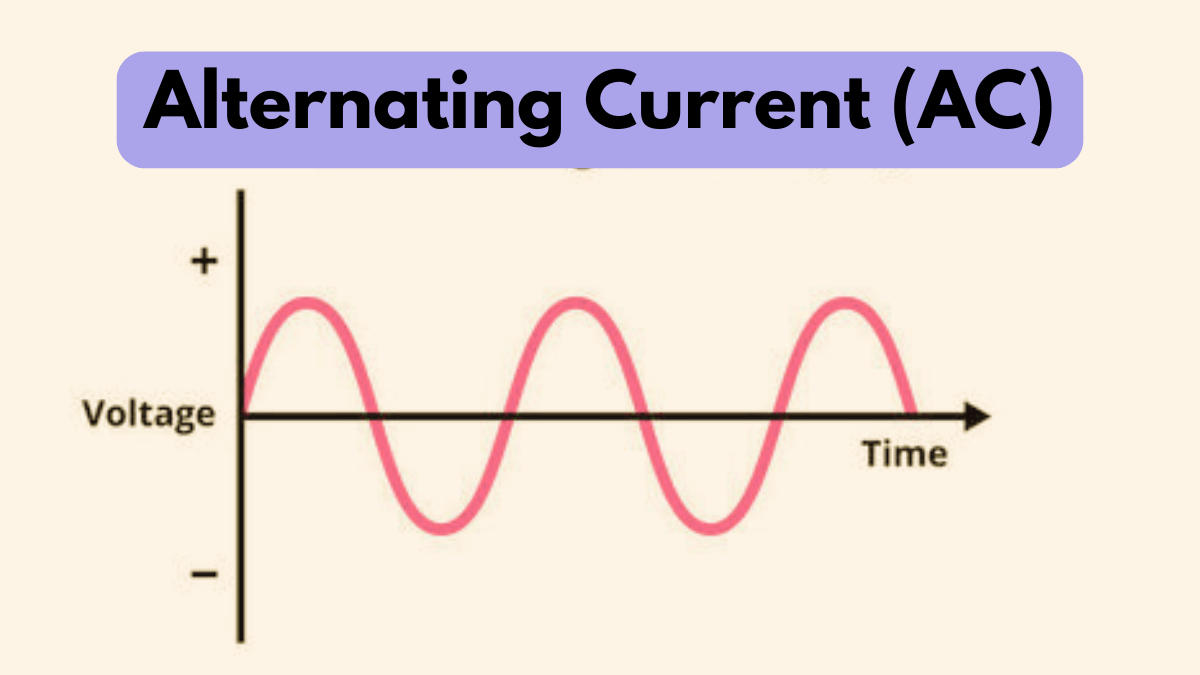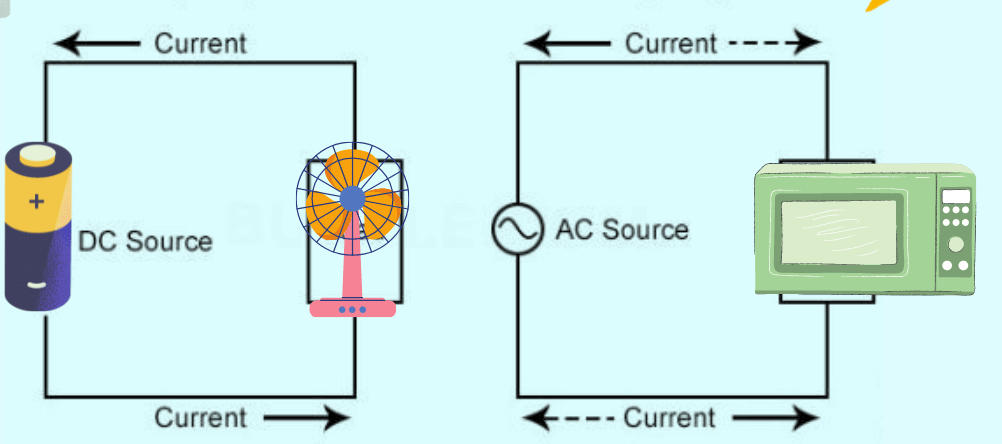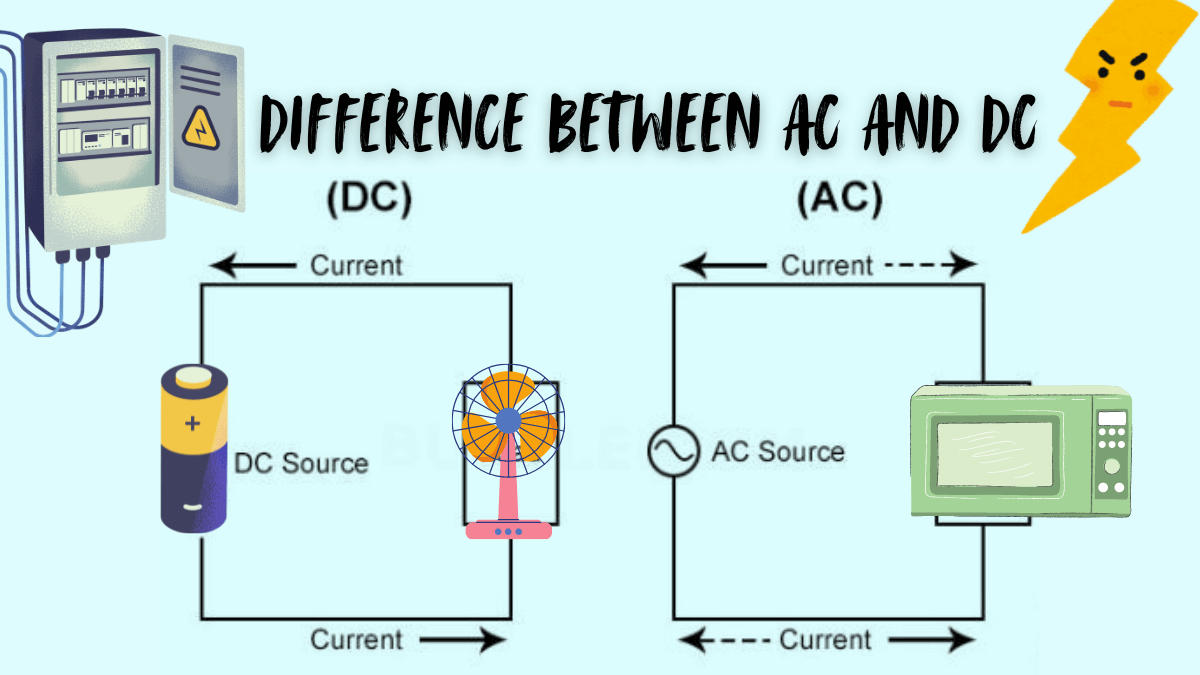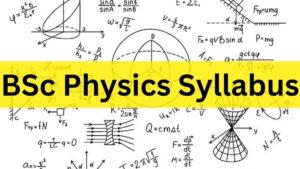Table of Contents
The main difference Between AC and DC Current is Direct current or DC is a system in which electricity always flows in a specific direction whereas in Alternating current or AC mechanism the correct flows forward and backward in regular intervals. We generally know that a battery supply the DC current where we got electricity from power plants in AC current form.
Difference Between AC and DC
There are two types of electric current – direct current (DC) and alternating current (AC). Direct current is similar to the flow of a river. It refers to the flow of electricity generated by batteries, solar cells, etc. Direct Currents cannot be transmitted over very great distances. It loses electrical power.
Alternating current (AC) is a mechanism in which the positive and negative sides are switched on and off at regular intervals, causing the direction of the flow of electricity to shift. This refers to the flow of electricity from a generator, power plants, and other outlets. AC can be easily carried across great distances, even between cities, with no energy loss. The electricity generated at power plants and distributed to houses is likewise transmitted as alternating current.
What is DC Current?
DC is the Direct Current. It is an electrical current that runs in a single direction. The electrons that make up the electric charge go from the point of low potential to the point of high potential when a direct current flows.

Characteristics
- DC goes from the negative terminal to the positive terminal, resulting in the opposite current (positive to negative).
- In DC circuits, the current flows in one direction, as opposed to alternating current. AC flips direction 50 or 60 times per second depending on the frequency of the supply.
- The voltage and current capacity of a DC power supply are determined by its design and components.
- An ideal DC supply should maintain a consistent voltage and current throughout the equipment’s operation. However, sources such as batteries have a finite capacity and can only power the devices efficiently for a set period, which is defined by the battery’s rating and load.
- There are many different DC voltage levels; popular values include 1.2, 1.5, 3, 3.3, 3.6, 5, 6, 10, 12, 15, 18, 18.5, 19, 20, 24, and 48 V.
What is AC Current?
Alternating Current (AC) is a form of electrical current in which the flow of electrons switches direction at recurring times or cycles. The current traveling through power lines and conventional domestic electricity is alternating current.

Characteristics
- Some countries use a standard current of 60 cycles per second or 60 Hz, but the majority of the globe uses 50 cycles per second.
- Energy is still essentially flowing constantly from the power plant to the electronic gadgets even with this current traveling back and forth several times per second.
- Alternating current (AC) switches the direction of the current, so not all of the electricity travels through the load, and some power is generated simply by passing back and forth between the load and the energy source. This is known as reactive power.
- A significant advantage of alternating current is that its voltage can be easily adjusted using a transformer, allowing power to be transported at extremely high voltages before being reduced to safer voltages for commercial and domestic use. This reduces energy losses.
Difference Between AC and DC
Here we have tabulated a total of 11 differences between AC and DC current. Read them below with the difference subject.
| Particulars | AC Current | DC Current |
| Direction | In alternating current, the flow of electricity alternates between forward and backward directions at regular intervals. | It flows steadily in one direction. |
| Resistance | In an AC circuit, there is resistance, a capacitor, and an inductor. | In a DC circuit, there is only resistance. |
| Distance Covered | AC may be transferred across large distances. | DC cannot be transported across vast distances. |
| Magnitude | The current magnitude varies with time. | The magnitude of the current is constant over time. |
| Direction Change | In AC, electrons constantly change directions, both backward and forward. | Electrons only go in one direction, forward. |
| Polarity | The positive and negative polarity of a direct current. | The positive and negative polarity of a direct current. |
| Power Factor | IN AC, the power factor ranges from zero to one. | The power factor is always one. |
| Effect of Magnet | The revolving magnets change the direction of electric flow. | The continuous magnetism causes DC to flow in a single direction. |
| Waves | Its waves are sinusoidal, triangular, square, and quasi-square. | The waveform is pure and pulsing. |
| Frequency | The frequency of alternating current varies by country, typically, the frequency is 50 or 60 Hz. | DC has zero or no frequency. |
| Power Source | Generators or mains power are used to provide availability. | The source of availability is a battery or cell. |

Advantages of AC Power Supply
AC current with its alternating positive and negative voltage, provides the following benefits and drawbacks.
| Advantages and Disadvantages of Alternating Current | |
| Advantages | Disadvantages |
|
|
Advantages of DC Power Supply
Direct current always flows in the same direction and offers the following advantages of DC Current.
| Advantages and Disadvantages of DC | |
| Advantages | Disadvantage |
|
|
Why is DC not used at home?
We use Alternating Current in home,s not Direct Current (DC) for the following reasons –
- This Alternating Current procedure is far more cost-effective and reliable. It’s also a lot easier to install than DC wiring, making it an excellent choice for households.
- DC is not as often used in houses. That’s because DC generates more heat and poses a fire risk, and converting high voltage to low voltage is more expensive.
- DC is difficult to manufacture since it is largely produced by batteries and the electrochemical processes of solar cells.
- AC can increase voltage in contrast to DC, which has a flat line. Power firms, for example, employ electric transformers to increase voltage. High-voltage wires transmit power throughout the country.
- Power loss during transmission is higher in direct current than in alternating current.
- AC power is more energy-effective than DC. It is safe to broadcast across longer distances, but it has inherent drawbacks.
Why AC is used in Ships?
In ships, AC is chosen over DC. These are the reasons for employing AC on onboard ships.
- The machine size is smaller, lighter, and more compact for a given kW.
- A transformer can raise or lower voltage.
- High-power and high-voltage AC generators are simply made.
- AC can be turned into DC.



 CBSE Class 12 Physics Viva Questions wit...
CBSE Class 12 Physics Viva Questions wit...
 BSc Physics Syllabus 2025: Check Year Wi...
BSc Physics Syllabus 2025: Check Year Wi...
 Physics Investigatory Project Class 12: ...
Physics Investigatory Project Class 12: ...










